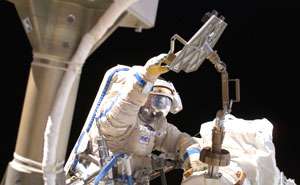Station Spacewalkers to Install Electrical Monitor

Space Station crew members Jeff Williams and Thomas Reiter will work to avoid future shocks during a scheduled 6-hour-plus spacewalk Aug. 3. They also will have a third station crew member for the first time in more than three years. Expedition 13 Commander Pavel Vinogradov will coach them through their prebreathe exercise program and help them suit up for their outing.
The station crew was reduced to two members in May 2003 in the wake of the Columbia accident. Since then, spacewalkers have had to reconfigure station systems before donning their spacesuits without help.
Once the spacewalk begins, Williams and Reiter will be coached through their tasks by Astronaut Steve Bowen. He will act as spacewalk intravehicular officer from the International Space Station Flight Control Room in Houston's Mission Control Center.
The first and longest major task of the spacewalk is installation of the Floating Potential Measurement Unit (FPMU). That device is designed to measure the electrical potential of the station so ways can be verified or devised to minimize arcing hazards as the ISS grows.
Williams, designated lead spacewalker (EV1), will wear the U.S. spacesuit with red stripes. Reiter, EV2, will wear the all-white suit.
They will spend about half an hour setting up equipment after they emerge from the Quest airlock shortly before 10 a.m. EDT. They'll then move with the FPMU to a camera mount near the upper outboard end of the S1 (starboard one) truss. Total time allotted for the installation is 1 hour, 50 minutes.
Next they'll move back to the airlock. There they'll install two Materials on International Space Station Experiment (MISSE) containers. MISSE 3 goes on one of the high-pressure tanks around the crew lock, while MISSE 4 is set up on Quest's outboard end.
The experiment, housed in suitcase-like containers left open, looks at the long-time effects of space on a variety of materials. The idea is to identify optimal materials for use in future spacecraft.
A little over three hours into the spacewalk, Williams will install a controller for a thermal radiator rotary joint on the S1 truss. Meanwhile, Reiter will replace a computer on S1.
While Reiter finishes that task, Williams will begin installation of a starboard jumper and spool positioning device (SPD) on S1. Reiter will inspect a radiator beam valve module SPD site and install one there if necessary, then move on to install a port jumper and SPD.
The jumpers are designed to improve the flow of ammonia through the radiators once that coolant is installed.
Williams will begin setup for the final major task, test of an infrared camera designed to detect damage in a shuttle's reinforced carbon carbon (RCC) thermal protection. The camera is designed to detect damage by variations in temperature between sound and damaged RCC test sections.
After possible get-ahead tasks by Reiter and perhaps Williams and 30 minutes of cleanup, airlock entry and pressurization, the spacewalk is scheduled to end at 4:15 p.m.
This is the third spacewalk for both Williams and Reiter. It is the 69th spacewalk to support station assembly and maintenance and the 22nd from the Quest airlock.
Source: NASA





















